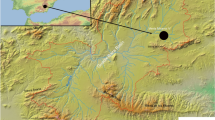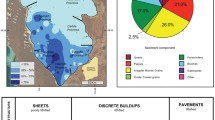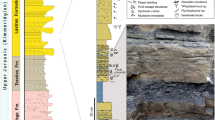Abstract
The remarkable occurrence of more than 4,500 conical siliceous mounds in an area of less than 1.5 square kilometres has been reported in the Paraná basin, near Anhembi, São Paulo, in southeastern Brazil1. These structures, which are up to two metres high, are thought to have been formed at the margin of a very shallow, broad but waning internal sea1, and it was originally suggested that they are stromatolites2. Yet their restricted occurrence, unusual abundance and nearly pure siliceous composition have never been satisfactorily explained by this hypothesis. Here we report field and laboratory observations on their shape, construction, composition and mineralogy. On the basis of our data we suggest that the conical mounds are the result of subaqueous Late Permian vent activity in southwestern Gondwana. The present siliceous cone field differs considerably from other Palaeozoic siliceous hot spring deposits, such as those at Rhynie, Scotland3, and the Drummond basin, Australia4, and therefore represents an unusual occurrence of vent activity.
This is a preview of subscription content, access via your institution
Access options
Subscribe to this journal
Receive 51 print issues and online access
$199.00 per year
only $3.90 per issue
Buy this article
- Purchase on Springer Link
- Instant access to full article PDF
Prices may be subject to local taxes which are calculated during checkout



Similar content being viewed by others
References
Matos, S. L. F. O Contato Entre o Grupo Passa Dois e a Formação Pirambóia na Borda Leste da Bacia do Paraná no Estado de São Paulo. 1–110, Master's thesis, Instituto de Geociências, Univ. São Paulo (1995)
Soares, P.C. Estruturas estromatolíticas do Permiano no estado de São Paulo. Res. Comun. Sess. Técnic. 1, 249 (Congresso Brasileiro de Geologia 26, Sociedade Brasileira de Geologia, Belém, 1972).
Rice, C. M., Trewin, N. H. & Anderson, L. I. Geological setting of the Early Devonian Rhynie chert, Aberdeenshire, Scotland: an early terrestrial hot spring system. J. Geol. Soc. Lond. 159, 203–214 (2002)
Cunneen, R. & Sillitoe, R. H. Paleozoic hot spring sinter in the Drummond Basin, Queensland, Australia. Econ. Geol. 84, 135–142 (1989)
Souza, P. A. & Marques-Toigo, M. An overview on the palynostratigraphy of the Upper Paleozoic strata of the Brazilian Paraná Basin. Rev. Mus. Argentino Cienc. Nat. (Nueva Serie) 5, 205–214 (2003)
Ragonha, E. W. & Soares, P. C. Ocorrências de carófitas fósseis na Formação Estrada Nova em Anhembi – SP. Anais 2, 271–275 (Congresso Brasileiro de Geologia 28, Sociedade Brasileira de Geologia, Porto Alegre, 1974).
Walter, M. R., Bauld, J. & Brock, T. D. in Stromatolites (ed. Walter, M. R.) 273–310 (Elsevier, Amsterdam, 1976)
Donaldson, J. A. in Stromatolites (ed. Walter, M. R.) 523–534 (Elsevier, Amsterdam, 1976)
Hofmann, H. J. Stratiform Precambrian stromatolites, Belcher Islands, Canada: Relations between silicified microfossils and microstructure. Am. J. Sci. 275, 1121–1132 (1975)
Tivey, M. K. The formation of mineral deposits at mid-ocean ridges. Oceanus 41(2), 22–26 (1998)
Haymon, R. M. Growth history of hydrothermal black smoker chimneys. Nature 301, 695–698 (1983)
Thurman, H. V. & Burton, E. A. Introductory Oceanography 1–554 (Prentice Hall, Englewood Cliffs, New Jersey, 2001)
Bryan, T. S. The Geysers of Yellowstone 1–462 (Univ. Press of Colorado, Niwot, 1995)
Guidry, S. A. & Chafetz, H. S. Anatomy of siliceous hot springs: examples from Yellowstone National Park, Wyoming, USA. Sedim. Geol. 157, 71–106 (2003)
Matos, S. L. F., Yamamoto, J. K., Riccomini, C., Hachiro, J. & Tassinari, C. C. Absolute dating of Permian ash-fall in the Rio Bonito Formation, Paraná Basin, Brazil. Gondwana Res. 4, 421–426 (2001)
Coutinho, J. M. V., Hachiro, J., Coimbra, A. M. & Santos, P. R. Ash-fall-derived vitroclastic tuffaceous sediments in the Permian of the Paraná Basin and their provenance. Proc. Int. Gondwana Symp. 7, 147–160 (1991)
Acknowledgements
We thank FAPESP (Fundação de Amparo à Pesquisa do Estado de São Paulo) and the CNPq (Conselho Nacional de Desenvolvimento Científico e Tecnológico), and J. V. M. Coutinho. Author Contributions J.K.Y. was the project leader, involved in all phases of the research; T.R.F. and P.C.B. did field and laboratory work, discussion and writing; T.J.M. and C.C.A. carried out field work; P.K.K. did laboratory work; S.L.F.M. and P.C.S. did field work and discussion.
Author information
Authors and Affiliations
Corresponding author
Ethics declarations
Competing interests
Reprints and permissions information is available at npg.nature.com/reprintsandpermissions. The authors declare no competing financial interests.
Supplementary information
Supplementary Figures
This file contains two photomicrographs of petrographic thin sections of chert from a siliceous cone in the Teresina Formation (Permian), Anhembi, Brazil, showing textural details of the various types of silica. (DOC 4972 kb)
Rights and permissions
About this article
Cite this article
Yamamoto, J., Fairchild, T., Boggiani, P. et al. A record of Permian subaqueous vent activity in southeastern Brazil. Nature 438, 205–207 (2005). https://doi.org/10.1038/nature04252
Received:
Accepted:
Issue Date:
DOI: https://doi.org/10.1038/nature04252
This article is cited by
Comments
By submitting a comment you agree to abide by our Terms and Community Guidelines. If you find something abusive or that does not comply with our terms or guidelines please flag it as inappropriate.



